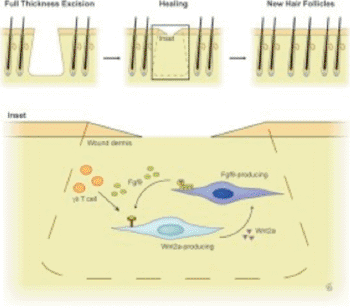Fibroblast Growth Factor Linked to Hair Regeneration During Wound Healing
By LabMedica International staff writers
Posted on 18 Jun 2013
Humans lack a specific subset of T-cells (gamma delta T-cells), which have been shown in a recent study to be critically linked to the regeneration of hair during wound healing.Posted on 18 Jun 2013
Previous studies carried out by investigators at the University of Pennsylvania (Philadelphia, USA) had linked Wnt signaling to regeneration of new hair follicles. The Wnt pathway involves a large number of proteins that can regulate the production of Wnt signaling molecules, their interactions with receptors on target cells, and the physiological responses of target cells that result from the exposure of cells to the extracellular Wnt ligands. Although the presence and strength of any given effect depends on the Wnt ligand, cell type, and organism, some components of the signaling pathway are remarkably conserved in a wide variety of organisms.

Image: Model depicting Fgf9-driven Wnt activation feedback loop (Photo courtesy of Dr. George Cotsarelis and Dr. Elsa Treffeisen, University of Pennsylvania).
The investigators sought to identify signaling molecules further upstream in the Wnt pathway that influence hair regeneration. Working with a mouse model, they found that Fgf9 (fibroblast growth factor 9 or glia-activating factor) was such a signaling molecule. Fgf9 is a member of the fibroblast growth factor (FGF) family of proteins. FGF family members possess broad mitogenic and cell survival activities, and are involved in a variety of biological processes, including embryonic development, cell growth, morphogenesis, tissue repair, tumor growth, and invasion. Fgf9 was isolated as a secreted factor that exhibited a growth-stimulating effect on cultured glial cells. In the nervous system, this protein is produced mainly by neurons and may be important for glial cell development.
Results obtained in the current study revealed that Fgf9 initially secreted by gamma delta T-cells, modulated hair follicle regeneration after wounding the skin of adult mice. Reducing Fgf9 expression decreased this wound-induced hair growth. Conversely, overexpression of Fgf9 resulted in a two- to threefold increase in the number of new hair follicles that were generated. Fgf9 from gamma delta T-cells triggered Wnt expression and subsequent Wnt activation in wound fibroblasts. Through a unique feedback mechanism, activated fibroblasts then expressed Fgf9, thus amplifying Wnt activity throughout the wound during the crucial phase of skin regeneration.
Humans lack a robust population of resident gamma delta T-cells in the skin, which may explain why we are usually unable to regenerate hair during wound healing. The importance of Fgf9 in hair follicle regeneration – as demonstrated in this study - suggests that it could be used therapeutically in humans.
"The findings help explain why humans do not regenerate their hair after wounding," said senior author Dr. George Cotsarelis, professor of dermatology at the University of Pennsylvania. "The study also points us to a way to treat wounds and grow hair."
The study was published in the June 2, 2013, online edition of the journal Nature Medicine.
Related Links:
University of Pennsylvania














